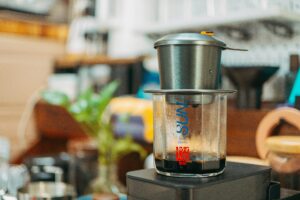Ever wondered if your morning coffee ritual could benefit more than just your energy levels? For coffee lovers, there’s good news. Those used coffee grounds might be the secret to healthier, happier indoor plants. In this blog post, we’ll explore the ins and outs of using coffee grounds for indoor plant care, offering practical tips and research-backed insights to help your plants thrive.
Why Use Coffee Grounds for Indoor Plants?
Coffee grounds are rich in nutrients and can be a fantastic addition to your indoor plant care routine. Let’s break down why they are beneficial.
Nutrient-Rich Composition
Coffee grounds contain essential nutrients like nitrogen, potassium, and phosphorus, which are crucial for plant growth. Nitrogen, in particular, helps in leaf development, making your plants lush and green.
Natural Pest Deterrent
The strong aroma of coffee can deter common pests like slugs and snails. By using coffee grounds, you can keep your indoor plants pest-free without resorting to chemical pesticides.
Improved Soil Structure
Adding coffee grounds to your soil can enhance its structure. The grounds create air pockets in the soil, improving drainage and aeration, which are vital for healthy root systems.
How to Prepare Coffee Grounds for Plant Use
Before you start spreading coffee grounds around your plants, it’s essential to prepare them properly.
Drying the Coffee Grounds
Wet coffee grounds can form mold, which is harmful to plants. Spread the used grounds on a baking sheet and allow them to dry completely before use.
Mixing with Other Organic Matter
Coffee grounds are best used when mixed with other organic matter like compost or mulch. This mixture prevents the soil from becoming too acidic and helps distribute nutrients evenly.
Avoiding Overuse
While beneficial, too much coffee can harm your plants. Use coffee grounds sparingly, mixing them into the soil or compost at a ratio of about one part coffee grounds to three parts other organic matter.
Which Plants Benefit Most from Coffee Grounds?
Not all plants love coffee grounds equally. Here are some indoor plants that thrive on this natural fertilizer.
Acid-Loving Plants
Plants like azaleas, gardenias, and blueberries prefer acidic soil. Coffee grounds can help lower the pH of the soil, making it more suitable for these acid-loving plants.
Foliage Plants
Indoor plants with lush foliage, such as snake plants and pothos, benefit greatly from the nitrogen in coffee grounds. This nutrient promotes leaf growth and keeps the foliage vibrant.
Flowering Plants
Flowering plants like roses and hydrangeas also appreciate the nutrient boost from coffee grounds. The added potassium and phosphorus support bloom production and overall plant health.
How to Apply Coffee Grounds to Indoor Plants
Applying coffee grounds correctly is crucial for maximizing their benefits. Here’s how to do it right.
Top Dressing
Sprinkle a thin layer of dried coffee grounds on the soil surface. Make sure not to create a thick layer, as it can compact and hinder water penetration.
Mixing with Potting Soil
Mix coffee grounds into your potting soil before planting. This method ensures even distribution of nutrients throughout the soil.
Composting
Add coffee grounds to your compost bin. Over time, they will decompose and become part of the rich compost that you can use to feed your indoor plants.
Potential Downsides of Using Coffee Grounds
While coffee grounds offer many benefits, they also come with some potential drawbacks.
Over-Acidity
Too much coffee can make the soil overly acidic, which can harm some plants. Always test your soil’s pH before adding large amounts of coffee grounds.
Mold Growth
If not dried properly, coffee grounds can develop mold. This can introduce harmful spores to your indoor environment and affect plant health.
Attracting Pests
While coffee grounds can repel some pests, they might attract others, like fungus gnats. Monitor your plants closely when you start using coffee grounds to see how they react.
Expert Tips for Maximizing the Benefits of Coffee Grounds
To get the most out of your coffee grounds, consider these expert tips.
Regular Monitoring
Keep an eye on your plants’ health after introducing coffee grounds. Look for signs of nutrient deficiency or excess and adjust your usage accordingly.
Seasonal Adjustments
Your plants’ nutrient needs may change with the seasons. Use coffee grounds more sparingly during slower growth periods and more generously during peak growing seasons.
Combining with Fertilizers
Coffee grounds should complement, not replace, your regular fertilization routine. Combine them with other organic or synthetic fertilizers to ensure a balanced nutrient supply.
Real-Life Success Stories
Many indoor gardeners have successfully integrated coffee grounds into their plant care routines. Here are a few examples.
The Green-Thumbed Barista
Sarah, a barista and avid gardener, started using leftover coffee grounds on her houseplants. She noticed a significant improvement in their growth and health, especially her ferns and spider plants.
The Eco-Friendly Gardener
Tom, an eco-conscious gardener, loves recycling his coffee grounds. He mixes them with compost and swears by the results, particularly for his flowering plants like orchids and African violets.
The Urban Gardener
Living in a small apartment, Jane found that coffee grounds were a convenient and cost-effective way to nourish her indoor herb garden. Her basil and mint plants have never looked better.
FAQs About Coffee Grounds and Indoor Plants
Can I Use Coffee Grounds Directly on My Plants?
It’s best to dry and mix coffee grounds with other organic matter before applying them to your plants to prevent mold and over-acidity.
How Often Should I Use Coffee Grounds on My Plants?
Use coffee grounds sparingly, about once a month, to avoid nutrient overload and soil imbalance.
Can Coffee Grounds Attract Pests?
While coffee grounds can repel some pests, they might attract others. Monitor your plants and adjust usage as needed.
Are Coffee Grounds Suitable for All Indoor Plants?
No, not all plants benefit from coffee grounds. Stick to acid-loving, foliage, and flowering plants for the best results.
Can I Use Fresh Coffee Grounds Instead of Used Ones?
Used coffee grounds are preferred because fresh ones are more acidic and can be too strong for most plants.
Conclusion
Using coffee grounds for indoor plants is a sustainable and effective way to recycle your daily brew while giving your plants a nutrient boost. By following the tips and guidelines outlined in this post, you can enjoy healthier, more vibrant indoor plants. Ready to get started? Gather those coffee grounds and watch your indoor garden thrive!
For more expert gardening tips and personalized advice, join our community of coffee-loving gardeners and take your plant care to the next level.
Happy brewing and growing!






